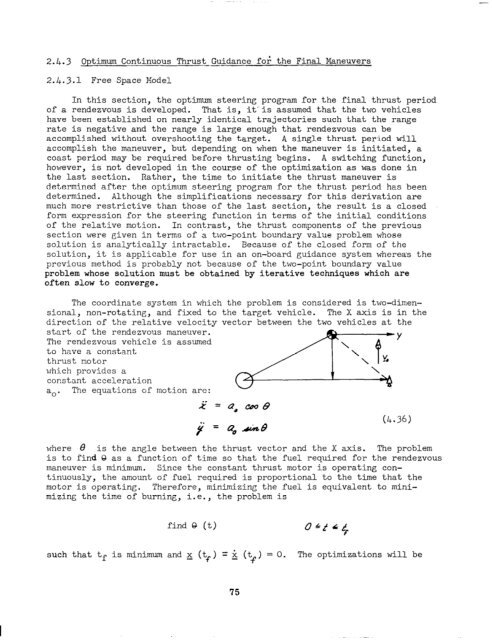guidance, flight mechanics and trajectory optimization
guidance, flight mechanics and trajectory optimization
guidance, flight mechanics and trajectory optimization
Create successful ePaper yourself
Turn your PDF publications into a flip-book with our unique Google optimized e-Paper software.
2.4.3 Optimum Continuous Thrust -- Guidance for: the Final Maneuvers<br />
2.4.3.1 Free Space Node1<br />
In this section, the optimum steering program for the final thrust period<br />
of a rendezvous is developed. That is, it'is assumed that the two vehicles<br />
have been established on nearly identical trajectories such that the range<br />
rate is negative <strong>and</strong> the range is large enough that rendezvous can be<br />
accomplished without overshooting the target. A single thrust period will<br />
accomplish the maneuver, but depending on when the maneuver is initiated, a<br />
coast period may be required before thrusting begins. A switching function,<br />
however, is not developed in the cour.se of the <strong>optimization</strong> as was done in<br />
the last section. Rather, the time to initiate the thrust maneuver is<br />
determined after the optimum steering program for the thrust period has been<br />
determined. Although the simplifications necessary for this derivation are<br />
much more restrictive than those of the last section, the result is a closed<br />
form expression for the steering function in terms of the initial conditions<br />
of the relative motion. In contrast, the thrust components of the previous<br />
section were given in terms of a two-point boundary value problem whose<br />
solution is analytically intractable. Because of the closed form of the<br />
solution, it is applicable for use in an on-board <strong>guidance</strong> system whereas the<br />
previous method is probably not because of the two-point boundary value<br />
problem whose solution must be obtained by iterative techniques which are<br />
often slow to converge.<br />
The coordinate system in which the problem is considered is two-dimen-<br />
sional, non-rotating, <strong>and</strong> fixed to the target vehicle. The X axis is in the<br />
direction of the relative velocity vector between the two vehicles at the<br />
start of the rendezvous maneuver.<br />
The rendezvous vehicle is assumed<br />
to have a constant<br />
thrust motor<br />
which provides a<br />
constant acceleration<br />
a,. The equations of motion are:<br />
where 8 is the angle between the thrust vector <strong>and</strong> the X axis. The problem<br />
is to find 8 as a function of time so that the fuel required for the rendezvous<br />
maneuver is minimum. Since the constant thrust motor is operating con-<br />
tinuously, the amount of fuel required is proportional to the time that the<br />
motor is operating. Therefore, minimizing the fuel is equivalent to mini-<br />
mizing the time of burning, i.e., the problem is<br />
find 8 (t) OLf Lt,<br />
such that tf is minimum <strong>and</strong> x (t,) = i (t,) = 0. The <strong>optimization</strong>s will be<br />
75<br />
-
















